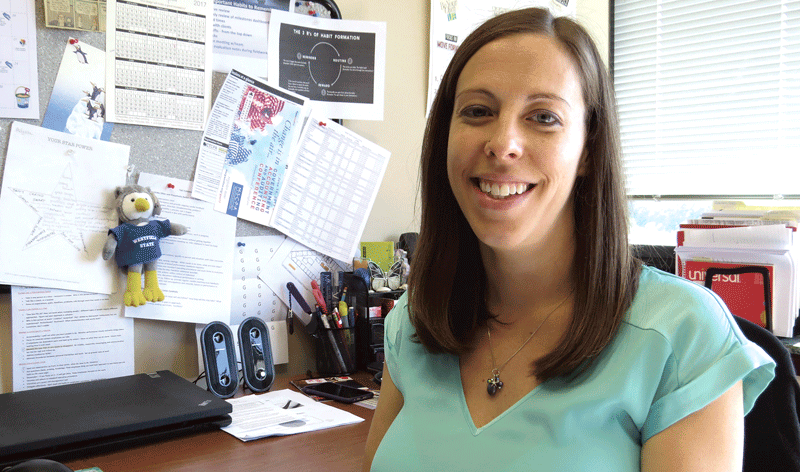
Accounting Firm’s Embrace of Six Sigma is Generating Results
A Different Kind of Number Crunching
 Since its introduction more than 30 years ago, the data-driven process-improvement methodology known as Six Sigma has been most closely associated with the manufacturing sector. But, as recent initiatives undertaken by the accounting firm Meyers Brothers Kalicka clearly show, this ‘lean’ concept can be utilized by companies in any business sector to improve efficiency and buy employees time — literally.
Since its introduction more than 30 years ago, the data-driven process-improvement methodology known as Six Sigma has been most closely associated with the manufacturing sector. But, as recent initiatives undertaken by the accounting firm Meyers Brothers Kalicka clearly show, this ‘lean’ concept can be utilized by companies in any business sector to improve efficiency and buy employees time — literally.
Melyssa Brown joked that when she earned her green belt in Six Sigma last year, she was disappointed when all that arrived in the mail confirming that accomplishment was a piece of paper, a certificate.
“I was thinking, hoping that maybe there would actually be a green belt — I could use an accessory like that,” she told BusinessWest, tongue firmly planted in cheek, adding quickly that just about everything else about Meyers Brothers Kalicka’s deep dive into this data-driven process-improvement methodology has been about what she and others at the Holyoke-based accounting firm expected.
And then some.
Our interaction with the client is better, and our delivery of services to the client is better. And internally, it has put everyone on the same page; it’s put everyone together behind a commitment to move forward and not stand still, because you can’t grow that way.”
Indeed, they were expecting that incorporation of this lean, quality-control program, developed by Motorola in 1986 and popular within the manufacturing sector, would be intense, time-consuming, and somewhat difficult because it constituted a significant change in how things were done.
They were right.
But they also expected it would achieve real results and provide powerful evidence that Six Sigma can work in the service sector as well as it does in the realm of manufacturing. And they were right again.
“Our interaction with the client is better, and our delivery of services to the client is better,” Brown, a senior manager in the auditing department at MBK, said of the net gains from the firm’s investments in Six Sigma. “And internally, it has put everyone on the same page; it’s put everyone together behind a commitment to move forward and not stand still, because you can’t grow that way.”
Elaborating, Brown said that, through Six Sigma, the company has been able to chart how the all-important time of partners, associates, and others at the firm is spent, with a critical eye toward making processes more efficient, thus essentially providing personnel with more time with which to better serve clients and serve more of them, critical elements in any company’s efforts to increase profits and improve market share.
Getting more specific, Brown said MBK has undertaken a few Six Sigma projects, both involving client interaction, the time spent accumulating needed information for tax and audit work, and efforts to bring more efficiency to those efforts.

Melyssa Brown says MBK’s Six Sigma projects have effectively given employees at the firm more of that most precious commodity — time.
“To do audit and tax work, you clearly need to get information from the client — we need some numbers to work with,” she explained. “It comes down to, when you have that interaction, how it’s done, and how it’s followed up.”
In short, there were inefficiencies with all those steps in the process, she went on, and, therefore, some diligent work was undertaken to mitigate them.
“From these processes, we’ve put structures in place to help us monitor and conduct better interactions with the client, because that’s what’s important to them — and us,” she went on, adding that the goal was and is to make these interactions easier for the client and more productive for the firm.
Fast-forwarding a little, Brown said the firm has created an online portal, or drop box, if you will, for client information that can be accessed by all those servicing that particular client. This innovation has significantly reduced the time, trouble, and anxiety involved with collecting and accessing that data, as will be explained in more detail later.
As noted, the company’s experience shows how Six Sigma can be applied to businesses not traditionally associated with this methodology, said Brown, who was a member of a panel that delivered that very message to assembled members of the Employers Assoc. of the NorthEast several weeks ago.
“Everyone has a back office,” Brown explained. “And while people think of Six Sigma in terms of manufacturing processes, those back-office functions can be made more efficient as well.”
For this issue and its focus on accounting and tax planning, BusinessWest departs from more traditional discussions about taxes, audits, legislation, and compliance, and takes a hard look at a different form of number crunching.
Time Is of the Essence
Brown told BusinessWest she became the company’s point person on Six Sigma … well, because each senior manager at the firm has a ‘niche,’ as she called it, and at that moment in time, she didn’t have one.
So Six Sigma became her niche.
Backing up a little, Brown said she and others at the firm were in attendance for a presentation on Six Sigma presented by a consultant and hosted by CPA America, a trade organization the firm has belonged to for some time. That seminar came about just as the firm was aggressively exploring methods for achieving process improvement, thus bolstering the bottom line.
“We had tried several other ways to become better at improving efficiency,” she explained. “But we needed that outside person’s view of what the best course of action might be.”
Brown underwent green-belt training, which introduces an overview of the key concepts, in Ohio, and took on a project involving one of her clients to earn that aforementioned certificate in 2016.
Summing up what’s been happening at the firm since, Brown said MBK has essentially embraced ‘lean,’ a concept that, as noted earlier, is usually associated with manufacturing, but can be applied to virtually any business sector.
Lean is a transferable and systematic approach for discovering, analyzing, prioritizing, and correcting time-wasting activities that exist in business processes, Brown told BusinessWest — and her audience at the EANE roundtable in May.
Elaborating, she said ‘lean’ is a mindset, or a culture, to reduce waste, something that exists in every operation and can be reduced — but only, in most all cases, through careful analysis of data and development of new ways to do business.
And, as Brown noted, this approach can generate positive results not only on the factory floor, but also in back-room operations such as billing and accounts receivable, accounts payable, payroll, monthly reconciliations, and financial reporting.
With that, she returned to the projects undertaken by MBK, and specifically that online portal she discussed. It came about through the Six Sigma process of analyzing a specific process or method of doing business, taking it apart, and putting it back together again — without the wasted steps, energy, time, and profit.
To get her points across, she undertook an exercise in ‘before and after.’
“Before, we would send a list of needed information via e-mail, in Word or Excel, and the client would either send us documents via e-mail, save it to a jump drive, or find some other way to get it to us,” she explained. “But it was never really clear if we had a certain piece; we would say, ‘do we have an accounts-receivable list?’ and they would say, ‘yes, you have it,’ and someone here would say, ‘I don’t think I do.’”
Now, with the online portal, such exchanges are a thing of the past, she went on, and so is the time lost looking for information or trying to verify whether the firm has it or not.
The bottom line, as they say in this business, is that the firm can now serve clients better and more efficiently, and use the time saved to serve other clients or solicit new ones.
And all of these things can be measured.
“In the end, our goal in this is to issue financial statements to clients earlier or get tax returns done and out to the client sooner than we used to, and we can measure this,” she explained.
Meanwhile, the system improvements are enabling individual service providers to make better use of their time, she went on, adding that, in many cases, it is now possible to do some audit-preparation work in October or November, thus creating more time during the extremely hectic months and weeks prior to April 15.
“You’re getting a head start on the client,” she noted, “which frees us up during tax season, when we’re all a little stressed.”
The end result, she said, is the creation of more time.
“Before, we may have thought that we needed to hire more people to get the work done,” she noted. “Now, we can get the same amount of work done with fewer hours and the same amount of people — or more work, because you’re taking on new projects with the time that you’ve saved.”
Looking forward, Brown said the firm is looking at other ways to put Six Sigma to use.
Indeed, after projects involving the tax and audit functions, the company is looking at possible initiatives involving billing and administration and making them more efficient.
“There are lots of opportunities — you just have to crack open the shell,” said Brown, who told BusinessWest that this is her general advice to all those who own or manage service businesses.
She noted that too many businesses in this sector are not embracing Six Sigma, in part because they don’t fully understand how it can be applied to their sector. But once educated to the contrary, many are put off by what amounts to a considerable commitment to this culture in terms of time, expense (usually, a consultant must be hired and new technology acquired), and needed buy-in from everyone at the company.
Those willing to make such a commitment, she said, should take the dive.
“This can’t be the flavor of the month,” she explained. “The tone at the top has be, ‘we’re going to make this work — this is our new way of doing business and operating.’”
It All Adds Up
As noted, Brown doesn’t have an actual green belt, like the ones awarded to those engaged in the martial arts.
But through the firm’s implementation of Six Sigma principles, she and others at MBK have something far more meaningful — additional time, the most precious commodity that exists in business today.
It came about through hard work and a deep dive into processes and ways of doing business, with an eye toward continuous improvement.
Historically, such words, phrases, actions, and, yes, results have generally been restricted to the world of manufacturing. But as Brown noted and MBK has shown, any service business can generate the same types of positive outcomes.
They just have to crack open the shell.
George O’Brien can be reached at [email protected]





